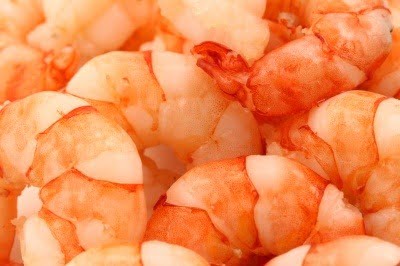
Chitinase (EC 3.2.1.14) – the enzyme needed to catalyse the breakdown of chitin, forms a key structural component of many living organisms. It is highly valuable in the waste processing world (Wang et al., 2011). Chitin is found in a diverse range of organisms – fungi, bacteria, insects, crustaceans and plants (Ajit et al., 2006; Song et al., 2012). It must be regularly degraded and resynthesized for such organisms to persist. Marine and soil bacteria rely especially on chitinases to replenish sources of saccharides for further bodybuilding (Orikoshi et al., 2005). They are also antimicrobials being produced by plants to resist fungal attack (Schlumbaum et al., 1986).
My recent post about processing shrimp waste did not do justice to the role chitinases play, but they are a critical component in generating silage and valuable products from such waste (Wang et al., 2006). Part of this process relies on soil borne bacteria and fungi, using chitinases, to degrade the chitin in this waste and return both carbon and nitrogen to the food chain. It has long been realised that such organisms are an integral part of the ecosystem especially these carbon and nitrogen cycles (Cohen-Kupiec and Chet, 1998).
The chitinase genes have been extensively studied and cloned from different bacteria (Shekhar et al., 2006; Song et al., 2012). They make ideal candidates for industrial applications. Bacterial chitinases are divided into 3 groups, denoted A, B, and C, which is based on the similarities of their amino acid sequences in the C-terminal catalytic domain (Suzuki et al., 1999). Chitinases have a size range of approximately 20 to 60 kDa but are typically smaller than their plant (25 to 40 kDa) and insect counterparts (40 to 85 kDa). They have a wide stability range, accommodating temperatures from 25 to 80 °C and pH 4.5 to 10.
The most prominent industrial application has been in agriculture (Jung et al., 2003) and pharmacology. Chitinases from the Actinomycetes inhibit the growth of phytopathogenic fungi by disrupting their cell wall synthesis and have been successfully used in protecting rice, soya and cotton. Transgenic technologies that include the expression of bacterial chitinase genes into cereal crops have provided success in resistance to common phytopathogenic fungal species (Barboza-Corona et al., 2003). The biotechnological applications of Bacillus thuringiensis for the control of pests and fungi have been richly explored with the engineering of heterologous chitinase genes from a number of bacterial resources (Ramirez-Reyes et al., 2004). Bacterial /viral chitinases also have an inherent property exploited in biotechnology, of dissolving the chitin-containing cell wall (Barboza-Corona et al., 2003; Oh et al., 2013), and thus accelerating protoplast generation. This has led to the development of economically important strains for bio-engineering (Shimosaka et al., 2001). Pharmaceuticals based on chitobiose and N-acetyl d-glucosamine produced by bacterial chitinases have also been generated (Felse and Panda 2000).
References
Ajit, N.S., Verma, R., Shanmugam, V. (2006) Extracellular chitinases of fluorescent pseudomonads antifungal to Fusarium oxysporum f. sp. dianthi causing carnation wilt. Curr. Microbiol. 52 pp. 310–6 https://www.nature.com/articles/324365a0
Barboza-Corona, J.E., Nieto-Mazzocco, E., Velázquez-Robledo, R., Salcedo-Hernández, R., Bautista, M., Jiménez, B., Ibarra, J.E. (2003) Cloning, sequencing, and expression of the chitinase gene chiA74 from Bacillus thuringiensis. Appl Environ Microbiol 69 pp. 1023–9.
Cohen-Kupiec, R., Chet, I. (1998) The molecular biology of chitin digestion. Curr. Opin. Biotechnol. 9 pp.270–7 https://doi.org/10.1016/S0958-1669(98)80058-X
Felse, P.A., Panda, T. (2000) Production of microbial chitinases—a revisit. Biopro. Engr. 23 pp.127–34.
Jung, W.J., An, K.N., Jin, Y.L., Park, R.D., Lim, K.T., Kim, K.Y., Kim, T.H. (2003) Biological control of damping-off caused by Rhizoctonia solani using chitinase-producing Paenibacillus illinoisensis KJA-424. Soil Biol Biochem 35 pp. 1261–4.
Oh, S., Kim, D.H., Patnaik, B.B., Jo, Y.H., Noh, M.Y., Lee, H.J., Lee, K.H., Yoon, K.H., Kim, W.J., Noh, J.Y., Jeong, H.C., Lee, Y.S., Zhang, C.X., Song, Y.S., Jung, W.J., Ko, K,, Han. Y,S. (2013) Molecular and immunohistochemical characterization of the chitinase genes from Pieris rapae granulovirus. Arch. Virol. 158 pp. 1701–18.
Orikoshi, H., Nakayama, S., Miyamoto, K., Hanato, C., Yasuda, M., Inamori, Y., Tsujibo, H. (2005) Roles of four chitinases (chia, chib, chic, and chid) in the chitin degradation system of marine bacterium Alteromonas sp. strain O-7. Appl Environ Microbiol 71 pp. 1811–5.
Ramirez-Reyes, A., Escudero-Abarca, B.I., Aguillar-Uscanga, G., Hayward-Jones, P.M., Barboza-Corona, J.E. (2004) Antifungal activity of Bacillus thuringiensis chitinases and its potential for the biocontrol of phytopathogenic fungi in soybean seeds. J. Food Sci. 69 pp. 131–4.
Shekhar N, Bhattacharya D, Kumar D, Gupta RK. 2006. Biocontrol of wood-rotting fungi with Streptomyces violaceusniger XL-2. Can J Microbiol 52 pp. 805–8.
Shimoasaka, M., Fukumori, Y., Narita, T., Zhang, X.Y., Kodaira, R., Nogawa, M., Okazaki, M. (2001) The bacterium Burkholderia gladioli strain CHB101 produces two different kinds of chitinases belonging to families 18 and 19 of the glycosyl hydrolases. J. Biosci. Bioengr. 91 pp. 103–5.
Schlumbaum, A., Mauch, F., Vögeli, U., & Boller, T. (1986). Plant chitinases are potent inhibitors of fungal growth. Nature, 324(6095), 365 https://www.nature.com/articles/324365a0
Song, Y.S., Seo, D.J., Kim, K.Y., Park, R.D., Jung, W.J. (2012) Expression patterns of chitinase produced from Paenibacillus chitinolyticus with different culture media. Carbohydr. Polym. 90 pp. 1187–92.
Suzuki, K., Taiyoji, M., Sugawara, N., Nikaidou, N., Henrissat. B., Watanabe. T. (1999) The third chitinase gene (chiC) of Serratia marcescens 2170 and its relationship of its product to other bacterial chitinases. Biochem J. 343 pp. 587–96.
Wang, S. L., Liang, T. W., & Yen, Y. H. (2011). Bioconversion of chitin-containing wastes for the production of enzymes and bioactive materials. Carbohydrate Polymers, 84(2), 732-742 https://doi.org/10.1016/j.carbpol.2010.06.022 .
Wang, S.L., Lin, T.Y., Yen, Y.H., Liao, H.F., Chen, Y.J. (2006) Bioconversion of shellfish chitin wastes for the production of Bacillus subtilis W-118 chitinase. Carbohydr Res 341 pp. 2507–15 https://doi.org/10.1016/j.carres.2006.06.027

Leave a Reply